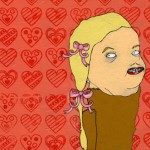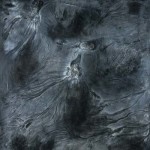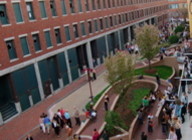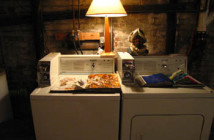The Rhys Gallery is located on an unassuming side street between a project and the discount liquor store. It's a beautiful, surprisingly comfortable and un-gallery feeling gallery. The split levels divide the space into more human sized rooms, couches and an open kitchen remind you of an apartment you wish you had, and the careful lighting is complimented by sun pouring in the window. Colin Rhys is pleased with it particularly for the dynamic of the three spaces. "[Each room] has a very different aesthetic, so the show operates like a dialogue between worlds. It forces pieces to relate and forces viewers to create their own relations and interpretations." Rhys' choice of the phrase "between worlds" seems particularly apt after looking around.
Hanging in Space 1 is the work of SMFA grad Tyler Brenton. Colin explained his process as something long developing - painting and sanding over and over and the result is something with astounding depth and subtlety. They give a sense of a very organic growth, but still carefully shaped and influenced. A phrase stood out to me in his artist's statement: "the natural world in flux." Naturalness is an elusive concept in art. The artist can only ever mimic it - to act on their piece as the laws of physics and biology act on the world. Each piece speaks of the labor that produced it: covering over and revealing. There is something universal in those shapes and forms. Like the Eames film "The Power of Ten", it takes you out to beyond galaxies, and back down into the skin, deep into cells, into atoms. It's uncertain whether what you're seeing is large or small, but it is something inside us, and around us. A universal found in extremes.
Vermont artist Abby Manock's work is based on the idea of Millenial Buzz: we believed that by now we would be living in the world of the Jetson's, with bubble cars and silver suits and rocket packs. But we don't. Manock aims to depict this place: all conduits and domes and intricate criss-crossing pathways. The appear chaotic at first, because they are crowded, but are in fact perfectly ordered, everything in its right place, waiting for everyone to come. What is unsettling about these pieces is that you get the feeling no one is coming back. It's been all set up, worked on, built, agonized over and planned to a T, and then something happens. There's no one there. We have this urge to create the perfect environment and the desire to control it, but can design really save the world? These toy-like cities signify a lost sense of place. They show fear of the natural world, and ignorance of ourselves.
Manock's and Ria Brodell's works inform each other nicely. They each involve the creation of a fantasy world. Brodell's is as natural as Manock's is unnatural. Rather than being empty, it is virtually non-existent without the characters that inhabit it. Her pieces outline a meeting of fantastic creatures - Birdmen and big fuzzy worms. What they do, why they're meeting, and where they came from is unclear, but they fit into their environment so perfectly and naturally that you have no doubt that it's for some useful, sensible purpose. Her vision is wonderfully complete - though characters are not named and their behavior is not catalogued in detail we can see from how they sit in the drawings with each other how they might behave, who they might be. Or maybe we have no idea but don't care because it's not for us to decide. There is a story to tell but it's not a story we know, like a natural history museum exhibit with all the explanatory placards taken down.
In Space 3, Suzanne Coady uses a cartoon-y style to draw what we all looked like at one point the worst point. Her portraits are very nicely rendered and gruesome. Like Beavis and Butthead but with better color and even more horrible detail. In a way it's a little terrifying to know that a human being can be depicted this way - with so much ugliness. We try so hard to appear attractive to one another and here that's all stripped away and we become horrible caricatures, every feature at war with the others: beady eyes, fat chins, snaggle teeth. Damn we're gross. Brian Willmont's work is a nice opposition to Coady's. His characters are little more than stick figures with Beatles-era mops of hair. His etched environments are simple his trees and buildings more like symbols than representations. They evoke the simplicity and open perspective of children's books by Mitsumasa Anno. The narratives are vague and urgent, like folktales.
Rhys hopes to make art accessible by openly encouraging viewers to interpret works in their own way. Then, he says, you can "just enjoy art for what it is." Which is the point.
- Ria Brodell, Wee Ones.
- Suzanne Coady, screenprint, acrylic and gouache on paper on panel, from an installation of 16 works.
- Tyler Brenton, Untitled, mixed media, 2005.
Links:
The Rhys Gallery
"Brenton, Manock, Brodell, Coady and Willmont" is on view through July 2005 at The Rhys Gallery.
All images are courtesy of the artist and The Rhys Gallery.







